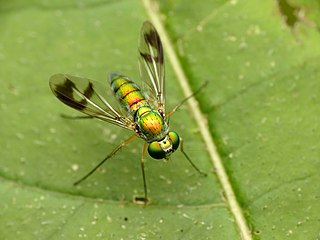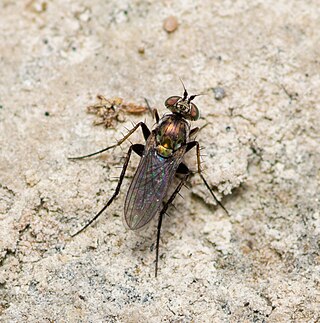Oedematopus is a genus of flies in family Dolichopodidae.
Anasyntormon is a genus of flies in the family Dolichopodidae. It was originally placed in the subfamily Rhaphiinae near Syntormon. It was transferred to Dolichopodinae by Hans Ulrich (1980), who found it to be congeneric or closely related to Hercostomus.

Arachnomyia is a genus of flies in the family Dolichopodidae. It is known from Australia.

Condylostylus is a genus of flies in the family Dolichopodidae. It is the second largest genus in the subfamily Sciapodinae, with more 250 species included. It has a high diversity in the Neotropical realm, where 70% of the species occur.

Diaphorus is a genus of flies in the family Dolichopodidae. Lyroneurus was formerly considered a subgenus, but is now either treated as a synonym of Chrysotus or treated as a distinct genus.
Falbouria is a genus of flies in the family Dolichopodidae. It contains only one species, Falbouria acorensis, which is endemic to the Azores. The genus was originally named Balfouria by Octave Parent in 1933; it was renamed to Falbouria by C. E. Dyte in 1980, after the name Balfouria was found to be preoccupied by the snail genus Balfouria Crosse, 1884.

Liancalus is a genus of flies in the family Dolichopodidae. It contains at least 21 species distributed worldwide except in Australasia and Oceania. The genus includes some of the largest species in the family, with body length approaching 12 mm in some species.
Metaparaclius is a genus of flies in the family Dolichopodidae. It is known from Papua New Guinea and Australia. The systematic position and monophyly of the genus are currently ambiguous: the holotype specimen of the type species, Metaparaclius subapicalis, was deposited in the Hungarian Natural History Museum, which was destroyed during the Hungarian Revolution of 1956, and no other specimens of this species are currently known.

Paraclius is a genus of flies in the family Dolichopodidae. It is currently considered a polyphyletic assemblage of species.
Rhynchoschizus is a genus of flies in the family Dolichopodidae. It contains only one species, Rhynchoschizus imbellis, and it is found in Albania. It was originally named Schizorhynchus by Octave Parent in 1927, but was renamed to Rhynchoschizus by C. E. Dyte in 1980 after it was found to be preoccupied by the flatworm genus Schizorhynchus.

Tachytrechus is a genus of long-legged flies in the family Dolichopodidae.

Thinophilus is a genus of flies in the family Dolichopodidae. It includes about 146 described species distributed worldwide. Most species of the genus are found in coastal habitats, while a few species are found in freshwater habitats.
Trigonocera is a genus of flies in the family Dolichopodidae. It is known from the Afrotropical, Oriental and Palaearctic realms.
Vetimicrotes is a genus of flies in the family Dolichopodidae. It is distributed in the Palaearctic realm. The genus was originally named Microtes by Theodor Becker in 1918. Afterwards, the name was found to be preoccupied by the grasshopper genus Microtes, so it was renamed to Vetimicrotes by C. E. Dyte in 1980.

Hydrophorinae is a subfamily of flies in the family Dolichopodidae. Several molecular phylogenetic analyses of the family have found evidence that the subfamily in its current sense is polyphyletic.

Dolichopodinae is a subfamily of flies in the family Dolichopodidae.

Diaphorinae is a subfamily of flies in the family Dolichopodidae.

Peloropeodinae is a subfamily of flies in the family Dolichopodidae. In some classifications, the genera of the subfamily are included in Sympycninae. According to a molecular phylogenetic analysis of the family Dolichopodidae by Germann et al. (2011), the subfamily is polyphyletic.

Sympycninae is a subfamily of flies in the family Dolichopodidae. In some classifications, this subfamily includes the genera of the subfamilies Peloropeodinae and Xanthochlorinae.











